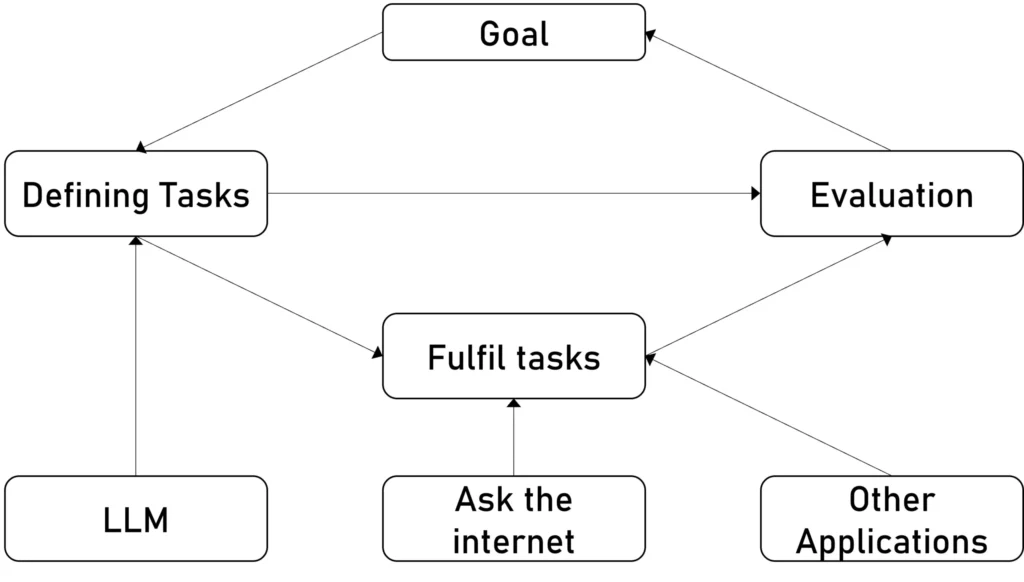With generative AI, another term has entered public parlance: AI agents. But what exactly is an AI agent and what does it do? That’s exactly what this blog post is about.
Table of Contents
Definition of an AI agent
An AI agent, short for artificial intelligence agent, is an independent software entity or autonomous system that uses artificial intelligence (AI) and machine learning to perform certain tasks, make decisions and interact in complex environments. An AI agent is able to collect and analyse data, recognise patterns and carry out actions independently based on these findings in order to achieve defined goals. An AI agent can take various forms, from simple virtual assistants to highly developed autonomous systems in areas such as industry, medicine, transport or customer service. Of course, AI agents can also interact with each other and set each other tasks.
What does this mean in concrete terms?
An AI agent can make decisions independently and is given a task for which it has to find a solution itself. To do this, it has to go through various steps:
- Goal setting by the user – What should the agent do?
- Define tasks
- Think and consider – What does the agent need to achieve the goal?
- Planning – How should the plan be implemented?
- Check – Do the planned steps make sense or does something need to be adjusted?
- Execute – Realisation of the defined tasks
- Finish/evaluation – Is the result close enough to the goal or do further tasks need to be defined to achieve the goal?

Example process flow diagram for an autonomous agent
Sounds quite technical, but what does it mean using an example?
Examples of AI agents
First of all, there are different types of agents that companies or individuals can use. Here are a few examples:
Example 1 – Autonomous AI agent in product development
One example of a use case for AI agents in a company would be an AI agent in product development. And this is how it would work:
- Target setting:
The user sets a goal: “Develop a concept for a new smartphone”. Based solely on the information that a large language model has, it will not be able to solve this task. After all, the point of an agent is not to answer a question based on the expertise of an LLM, but to fulfil a task.
- Thinking and reasoning
In order to fulfil the task, the AI agent has to think about how to reach its goal. This could mean, for example, that the agent suggests the following steps:
- Analyse customer reviews of smartphones on the internet
- Analysing market trends
- In-house analysis of existing data and expertise within the company.
- Use the results of the sub-steps to present the concept for a new smartphone on this basis.
- Planning
In theory, this sounds quite logical. From a technical perspective, however, it means that the AI agent needs access to various systems: customer ratings from smartphones, access to the market trend database and internal expertise – for example via an enterprise search. On the one hand, the AI agent needs the right data basis and authority/access for each step – which it must of course obtain in advance. For each step, the AI agent must decide how to arrive at the correct result. This must be planned by the AI agent.
- Check
In this phase, the AI agent should critically scrutinise its ideas and try to uncover its own weaknesses. In the event of inconsistencies, the AI agent should ideally be programmed to correct the first steps.
- Execute
Once the plan has been finalised, the AI agent must execute it.
- Finish/evaluation
Once the tasks have been completed, the agent must check whether the goal has been achieved or whether improvements have been made and jump back to step 2.
Example 2 – personal AI agents for sorting data
Another example could be the following task:
- Target:
Sort my hard drive new
- Think and consider
- I need an overview of the available information
- I need a concept of how I want to file information
- I need to be able to assess the criteria according to which documents are filed and how.
- Documents need to be moved.
- Planning
To fulfil the task, function a, b, c, … is required
- Check
Questioning the plan, possible correction
- Execute
Realisation of the plan
- Finish/evaluation
Completion of the task with a small report
Example 3 – personal agent for holiday booking
- Goal:
Book the cheapest possible holiday to Mallorca in August
- Think and consider
- General conditions for a holiday (budget, travel times, …)
- Research and analysis
- Selecting and filtering offers
- Negotiating prices and looking for discounts
- Booking processing
- Planning
To fulfil the task, function a, b, c, … is required
- Check
Does the process make sense and are the things that happen in the process coherent?
- Execute
Realisation of the plan
- Finish/evaluation
Booking the holiday
Best practices and technical background for the introduction of AI in companies
With amberSearch, we help employees to make internal expertise quickly and easily accessible. Time and again, we realise that there is a lot of half-knowledge “floating around”, which is why we have made it our mission to improve knowledge with our blog. If you would like to learn more about the technical basics of introducing (generative) AI in your company in addition to AI agents, then take a look at this blog article.
Challenges and dangers
The examples show that the realisation of an AI agent can quickly become complex. But what are the specific challenges?
One challenge with these agents is endless loops. If the target definition is too imprecise or unattainable, the agent may get stuck in an infinite loop.
Of course, it could also be that the AI agent in example 2 starts deleting files unintentionally or in example 3 starts spending vast sums of money on the wrong things. Therefore, AI agents should be handled with caution.
In principle, such agents can only be successful if they have access to the relevant data. For most use cases, however, it is quite difficult to build such bots for large-scale applications for companies with comprehensible effort (and data protection approvals).
Different types of agents
Web agents: These agents search the internet, collect data and deliver relevant information to users. They include search engine bots such as Googlebot and price comparison agents that search the web for products and compare prices.
Autonomous agents: These agents act autonomously in physical or digital environments, without direct human control. They include self-driving cars that navigate traffic autonomously and robots in the manufacturing industry that perform repetitive tasks.
Customer interaction agents: These agents interact with users to provide information or complete tasks. They include chatbots in customer service that use natural language processing, as well as virtual assistants such as Amazon Alexa or Google Assistant that help users with a variety of tasks.
Ethical discussion on AI agents
The use of AI agents brings with it a number of ethical challenges that should not be neglected when using AI agents:
- Data protection and privacy: AI agents often collect and process large amounts of data. Compliance with the GDPR must be ensured.
- Discrimination: AI algorithms are trained with a data set created by humans and are therefore never free of prejudice. This makes it all the more important that their decisions are as objective and unbiased as possible.
- Transparency and traceability: For systems that make decisions, it must be possible to understand why which decision was made and how it was made.
- Responsibility and liability: When an AI makes purchasing decisions or similar – who is liable in the event of errors? The user or the manufacturer?
- Social aspects: How do we as a society deal with it when humanity loses autonomy?
Future outlook for AI agents
Artificial intelligence continues to develop at an unstoppable pace and so more and more AI agents will come onto the market for more and more use cases, capable of solving increasingly complex tasks. A possible scenario of how AI agents could be used in the future is shown in this video:
You are currently viewing a placeholder content from YouTube. To access the actual content, click the button below. Please note that doing so will share data with third-party providers.
More InformationIn many use cases, however, individual AI agents are not sufficient. This is why they are increasingly being integrated into a multi-agent system. You can find out what a multi-agent system is in this blog article. The procedure shown in the video is also a multi-agent system that could potentially be used in the future.
